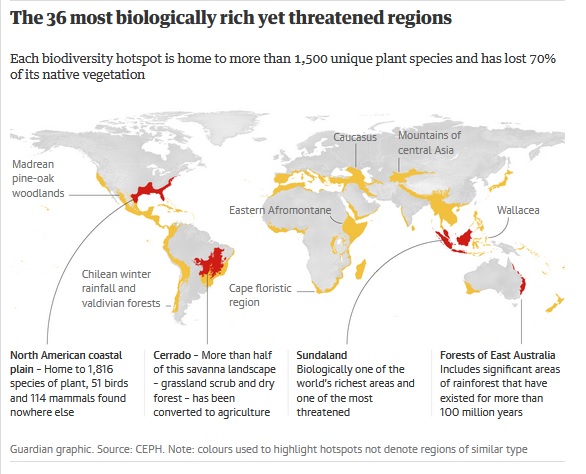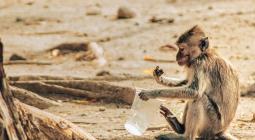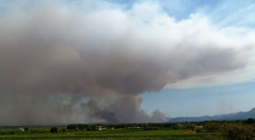‘We need a breakthrough deal on biodiversity’: can Montreal summit deliver for nature?

In 201o, politicians pledged to halt devastation of Earth’s wildlife. Since then, no progress has been made. And despite glimmers of hope, prospects look grim for next month’s top-level meeting in Canada
In 2010, politicians and scientists made a pledge to halt the devastating reductions in wildlife numbers that had been denuding the planet of its animals and sea creatures for the previous century. At that time, wild animal populations were declining by about 2.5% a year on average as habitat loss, invasive species, pollution, climate change and disease ravaged habitats and lives. Such losses must end within a decade, it was agreed.
Next month, conservationists and politicians will meet in Montreal for this year’s biodiversity summit where they will judge what progress has been made over the past 12 years. “It will be an easy assessment to make,” said Andrew Terry, the director of conservation at ZSL, the Zoological Society of London. “Absolutely no progress has been made. Populations have continued to decline at a rate of around 2.5% a year. We haven’t slowed the destruction in the slightest. Our planet’s biodiversity is now in desperate peril as a result.”
The aim of the Canadian Cop15 biodiversity summit is to adopt a globally agreed plan – the Post-2020 Global Biodiversity Framework – for living in harmony with nature. The vision is that by 2050, biodiversity will be valued, restored and conserved. Prospects of success look grim, however – a point emphasised last month in the WWF’s Living Planet report 2022, which uses data from the ZSL’s Living Planet index. It highlighted some of the starkest effects humans have had on life on Earth.
Creatures affected included the Amazon pink river dolphin (Inia geoffrensis) whose population in the Mamirauá reserve in Brazil plummeted by 65% between 1994 and 2016; the South and Western Australian sea lion pups (Neophoca cinerea) which declined by 64% between 1977 and 2019; and the ocean shark and ray populations, which have fallen by 71% since 1970.
Grimmer still has been the fate of vaquita porpoise (Phocoena sinus). Twenty years ago, there were about 600 swimming around the Gulf of California. Today, illegal fishing has ensured fewer than a dozen of these distinctive cetaceans are left alive. “Essentially, we are sitting back and watching this species go extinct,” said Terry.
Similarly, the Sumatran tiger and Bornean orangutan have been pushed to the edge of extinction along with the piping plover and the hellbender salamander in North America. Today, just 4% of the world’s mammals are wild; the other 96% are made up by humans and their livestock.
However, it is not the numbers that cause most dismay, said Tanya Steele, the chief executive of WWF UK: “It’s the fact that there is absolutely no action – world leaders are missing in action.”
It is a point endorsed by Terry. “Presidents and prime ministers flocked to the climate summit in Egypt this month. I doubt if many will turn up in Montreal. Biodiversity is not considered to be that important. Yet it underpins the food we eat and the air we breathe and protects us from pollution, flooding and climate breakdown.”
While climate issues now attract the attention of many government agencies – finance, health, labour and others – biodiversity is still confined to environment ministries, which are among the least influential departmentswith most governments. The result has been a complete failure to protect the world’s wildlife.

An illustration of the problem is provided by the UK. In February 2021, a government report – on the financial value of wildlife – was published by Sir Partha Dasgupta, a Cambridge economist. He argued that biodiversity should be included in assessing a nation’s economy, not just GDP, an analysis that mirrored Nicholas Stern’s 2006 Treasury-inspired review which helped transform economic understanding of the climate crisis. Despite its warm reception, the Dasgupta report appears to have been shelved.
“It seems to have fizzled out,” said Robin Freeman, a ZSL researcher and one of the authors of the Living Planet report. “It’s frustrating that as one of the countries that should be leading on this kind of initiative, we can’t even claim that we’re doing well ourselves.” In the report, the authors highlighted several areas of particular concern. Of these, freshwater systems – rivers, lakes and wetlands – are suffering some of the worst effects of biodiversity loss. Overall, wildlife populations have dropped by 69% since 1970 but in freshwater habitats there has been a decline of 83%.
“Just think of river systems,” said ZSL researcher Louise McRae, also an author of the Living Planet report. “Many major rivers are no longer free flowing. They have been dammed with impacts on migratory fish species. Then there is pollution, agricultural runoff and overfishing. For species such as freshwater cetaceans, tropical amphibians and others, it has been devastating.”
An example of these impacts is provided by the Baiji (Lipotes vexillifer), a freshwater dolphin native to the Yangtze river. It has not been observed since 2002 and five years go was declared possibly extinct.
It is a grim, depressing picture. Yet there are some glimmers of hope, say researchers who point to occasional conservation successes. Nests of loggerhead turtles (Caretta caretta) have increased after conservation measures by 500% along Chrysochou Bay in Cyprus between 1999 and 2015 while in the UK, the common crane (Grus grus) – which had become extinct – is now thought to number more than 200 individuals after a reintroduction programme launched in 2010.
Even more remarkable have been the conservation efforts in the Virunga mountains – along the northern border of Rwanda, the Democratic Republic of the Congo and Uganda – where conservationists have helped numbers of mountain gorillas (Gorilla beringei beringei) grow from 480 in 2010 to 604 in 2015-16, despite civil unrest that afflicts the region.
Such stories show that it is possible to tackle wildlife loss – but it will not be easy, added Terry. “We need to establish goals that are ambitious, accountable and measurable. And the developing world will need financial aid to save its wildlife. “Ultimately, a lot of this is going to come down to the same issues that beset the climate process. It had its moment of triumph in Paris in 2015. And that is what we are going to need in Montreal next month. We need a breakthrough deal, a Paris moment – because if we don’t get a transformation in our attitude to biodiversity loss, the planet will be in a great deal of trouble.”
cover photo: A loggerhead turtle (Caretta caretta) emerges from its egg in Anatalya, Turkey. Conservation measures have increased numbers of the turtles’ nests in Cyprus. Photograph: Anadolu Agency/Getty Images






